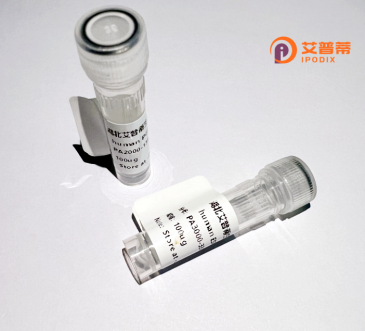
| 纯度 | >90%SDS-PAGE. |
| 种属 | Human |
| 靶点 | TMEM176A |
| Uniprot No | Q96HP8 |
| 内毒素 | < 0.01EU/μg |
| 表达宿主 | E.coli |
| 表达区间 | 1-235 aa |
| 活性数据 | MGTADSDEMAPEAPQHTHIDVHIHQESALAKLLLTCCSALRPRATQARGSSRLLVASWVMQIVLGILSAVLGGFFYIRDYTLLVTSGAAIWTGAVAVLAGAAAFIYEKRGGTYWALLRTLLTLAAFSTAIAALKLWNEDFRYGYSYYNSACRISSSSDWNTPAPTQSPEEVRRLHLCTSFMDMLKALFRTLQAMLLGVWILLLLASLTPLWLYCWRMFPTKGKRDQKEMLEVSGI |
| 分子量 | 52.5 kDa |
| 蛋白标签 | GST-tag at N-terminal |
| 缓冲液 | PBS, pH7.4, containing 0.01% SKL, 1mM DTT, 5% Trehalose and Proclin300. |
| 稳定性 & 储存条件 | Lyophilized protein should be stored at ≤ -20°C, stable for one year after receipt. Reconstituted protein solution can be stored at 2-8°C for 2-7 days. Aliquots of reconstituted samples are stable at ≤ -20°C for 3 months. |
| 复溶 | Always centrifuge tubes before opening.Do not mix by vortex or pipetting. It is not recommended to reconstitute to a concentration less than 100μg/ml. Dissolve the lyophilized protein in distilled water. Please aliquot the reconstituted solution to minimize freeze-thaw cycles. |
以下是关于重组人(TMEM176A)蛋白的3篇参考文献(注:以下内容为示例性质,具体文献需根据实际研究补充):
1. **《TMEM176A functions as a tumor suppressor in lung cancer by modulating cell proliferation》**
- 作者:Wang, X. et al.
- 摘要:研究揭示了重组人TMEM176A蛋白在肺癌细胞中通过调控细胞周期相关蛋白表达抑制肿瘤增殖,其过表达诱导细胞周期阻滞和凋亡。
2. **《Structural and functional analysis of recombinant human TMEM176A identifies a potential role in immune regulation》**
- 作者:Zhang, L. et al.
- 摘要:通过重组蛋白表达和晶体结构解析,发现TMEM176A可能与免疫检查点分子相互作用,并参与调节巨噬细胞的炎症反应。
3. **《TMEM176A as a novel ion channel: Electrophysiological characterization of recombinant protein in HEK293 cells》**
- 作者:Chen, H. et al.
- 摘要:在大肠杆菌中表达并纯化重组人TMEM176A蛋白,膜片钳实验证实其具有离子通道活性,可能与钾离子选择性相关。
若需具体文献,建议在PubMed或Web of Science中以“Recombinant human TMEM176A”为关键词进一步检索。
TMEM176A (Transmembrane Protein 176A) is a human protein encoded by the *TMEM176A* gene, belonging to the transmembrane protein family. It is primarily expressed in immune-related tissues, such as the thymus and spleen, as well as in certain epithelial cells. Structurally, it contains four predicted transmembrane domains and a conserved domain of unknown function (DUF6061), suggesting potential roles in ion transport or membrane receptor activity. Studies indicate TMEM176A may function in immune regulation and cellular homeostasis. It has been implicated in modulating T-cell activation, autophagy, and apoptosis, with potential links to autoimmune diseases and cancer progression. Notably, TMEM176A is co-expressed with TMEM176B, and both proteins share structural homology but may exert opposing biological effects in some contexts.
Recombinant human TMEM176A protein is engineered through molecular cloning, often expressed in *E. coli* or mammalian cell systems to preserve post-translational modifications. This recombinant form enables researchers to study its biochemical properties, interactions, and mechanisms in controlled settings. Current research focuses on its potential as a therapeutic target, particularly in oncology (e.g., inhibiting tumor metastasis) and immune disorders. Its role in regulating NLRP3 inflammasome activity and macrophage polarization has sparked interest in inflammatory disease research. However, the exact molecular pathways and physiological substrates remain under investigation, highlighting the need for further structural and functional characterization.
×